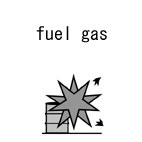| Case Name |
Explosion at a furnace caused due to fuel gas leakage on starting-up of a catalytic reforming unit. |
| Pictograph |

|
| Date |
January 21, 1986 |
| Place |
Kawasaki, Kanagawa, Japan |
| Location |
Refinery |
| Overview |
An explosion accident occurred in a catalytic reforming unit which is one of the main units of a petroleum refinery. In the catalyst regeneration operation of the reactor, an explosion occurred. Fuel gas was introduced also into the main burner fuel line when it was introduced into the pilot burner fuel line. Although the block valves of the piping for the main burner were duplicated, the valve upstream was opened. Some of closed block valves at the downstream side leaked. Fuel gas was leaking in the furnace while fuel gas was introduced into the fuel piping for the main burner. At the furnace inside, a flammable gas-air mixture was generated when the pilot burner was ignited, and the explosion was caused. |
| Incident |
In a catalyst regeneration operation of a catalytic reforming unit of the refinery, an explosion occurred in the heating furnace while igniting the pilot burner of the furnace. |
| Processing |
Manufacture |
| Individual Process |
Maintenance |
| Chemical Reaction |
Other (cat-reforming) |
| Substance |
Fuel gas |
| Type of Accident |
Explosion |
| Sequence |
On January 20th, 1986. Nitrogen substitution in equipment related to catalyst regeneration such as a reactor and heating furnace tubes was completed.
On January 21st, 1986.
09:00: Operation of a compressor started to introduce nitrogen gas into naphtha circulation piping.
09:30: Blowing of steam into the furnace for purging started.
09:50: Blowing of steam stopped.
09:51: Fuel gas was introduced into fuel piping for pilot burners and piping for main burners.
09:55: Ignition of pilot burners started. An explosion occurred inside the furnace when 9th pilot burner was ignited.
Pilot burner: A small burner mounted to ignite the main burner. During operation, the pilot burner has the role of flame stabilization so that the flame of the main burner would not go out. |
| Cause |
1. The furnace operating manual was not followed. Fuel gas was also introduced into the main burner gas line when introducing fuel gas into the pilot burner gas line.
2. Block valves of the main gas line had been duplicated, however, because the valve at the upstream side had been opened, it was not a redundant system.
3. Some of the closed block valves downstream leaked. Fuel gas leaked into the furnace while fuel gas was introduced into the main line.
4. Therefore, the inside of the furnace came within the flammable range when the pilot burner was ignited, and the explosion was caused. |
| Countermeasures |
1. Strengthening education and training for operator.
2. It has to be described clearly in the operation manual to confirm that the pressure in downstream piping from the block valve is to be "0" before the pilot burner is ignited.
3. Maintenance of the valve is strengthened by strengthening leakage inspection of the block valve of fuel gas piping, etc. |
| Knowledge Comment |
If an operator thinks the operation of the safety device by doubling is troublesome, the operator tends to change it to single operation to simplify the operation. Therefore, the importance of the dual system must be well understood through education. The example of duplication: a serial double valve as in this example and doubling the control room doorway.
It is necessary to recognize that a valve can leak. |
| Background |
It is speculated that education and training were imperfect. The operator did not understand the meaning of duplication of the block valves of the fuel piping connected to a main burner and a valve might leak sometimes. Or, such education might not have been given. |
| Reason for Adding to DB |
Example of accident caused due to human error from simplified operation by operators |
| Scenario |
| Primary Scenario
|
Organizational Problems, Poor Management, Slackness of Management, Poor Value Perception, Poor Safety Awareness, Insuficient Education/Training for Safety, Carelessness, Insufficient Understanding, Insufficient Recognition of Risk, Planning and Design, Poor Planning, Poor planning for Operating Work, Non-Regular Operation, Change in Operation, Change Operation Procedure, Secondary Damage, External Damage, Leakage/Explosion, Bodily Harm, Injury, 1person injured
|
|
| Sources |
National dangerous object safe association, Explosion of heating furnace in petroleum reforming process, One hundred cases of accidents at hazardous facilities, pp.9-10(1991)
High Pressure Gas Safety Inst. of Japan, Catalytic reforming unit, Furnace explosion caused by fuel gas in a heating furnace leaking out, Accident examples of Petroleum refinery and Petrochemical units, pp.60-61(1995)
|
| Number of Injuries |
1 |
| Physical Damage |
The north side wall of the furnace collapsed, bricks were destroyed. |
| Notes |
Catalytic reforming unit: A unit that mainly produces aromatics such as toluene and xylene by cyclization-dehydrogenation reaction from heavy naphtha using a platinum-chlorine catalyst. It was developed as a raw material manufacturing unit of high octane gasoline. It is paid attention as a manufacturing unit of p-xylene raw material, which is a raw material of polyester and PET at present. |
| Field |
Chemicals and Plants
|
| Author |
OGAWA, Terushige (Graduate School of Environment and Information Sciences, Yokohama National University)
TAMURA, Masamitsu (Center for Risk Management and Safety Sciences, Yokohama National University)
|
|